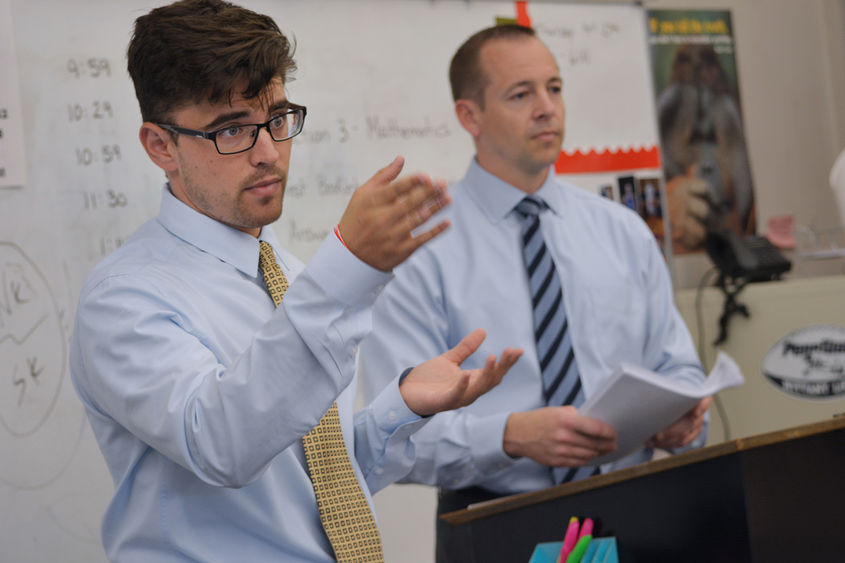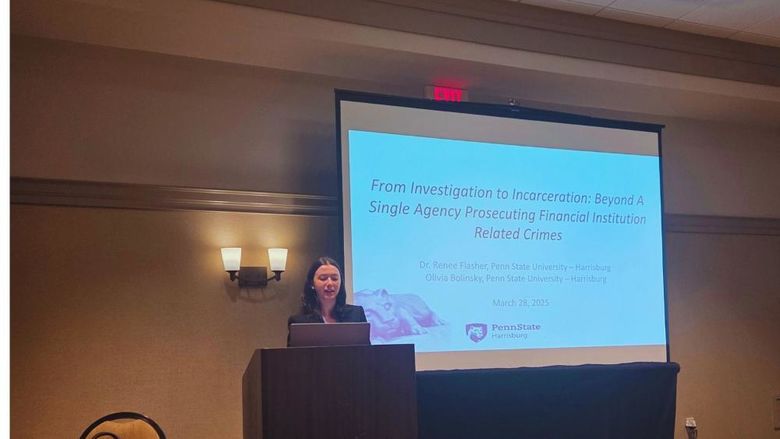
This spring, secondary education social studies major Tyler McFarland (left) co-taught in Derek Shaffer's (right) eighth grade American history classes at Lower Dauphin Middle School in Hummelstown, Pennsylvania.
HARRISBURG, Pa. — In 2014, Penn State Harrisburg launched Project EXCELLENCE, or “Partnerships for Teaching and Leadership Excellence,” an initiative designed to support student teaching partnerships and professional development opportunities for local school districts, thanks to a $1.87 million grant from the Pennsylvania Department of Education.
With the project launch came the new co-teaching model, an innovative way for elementary and secondary education students to collaborate with classroom teachers and receive valuable training in a more hands-on way than traditional student teaching provides. The model shifts the role of student teachers from an apprentice-like position to that of a true partner in the classroom, allowing education majors the ability to engage in the planning and implementation of lessons from day one. The approach benefits soon-to-be teachers and those already seasoned in the classroom.
Since the shift from traditional student teaching to co-teaching was implemented, Derek Shaffer, eighth-grade American history teacher at Lower Dauphin Middle School, has had three co-teaching students in his classroom from Penn State Harrisburg. The model, he said, is an effective way to immediately involve student teachers in the classroom and is mutually beneficial for the teachers.
“Personally, co-teaching gives me the opportunity to see the latest and greatest strategies and technologies being taught or used by education majors,” Shaffer said. “I believe the co-teaching model allows the classroom teacher the chance to learn as much from the student teacher as the student teacher does from the classroom teacher.”
Having two teachers in the classroom provides a better teacher-student ratio and gives student teachers the opportunity to work with more kids on a daily basis, he said.
“When the chemistry has been developed properly, there isn’t any doubt that my students respond better to the co-teaching model than the traditional model,” he added. “The ability to work with more students on a regular basis allows us to ensure topic comprehension for more students.”
Tyler McFarland, a secondary-education social-studies major who graduated in May after teaching with Shaffer this spring, appreciated the collaborative opportunities provided by co-teaching. Writing lesson plans and getting a feel for how much content can fit into one 45 minute period can be challenging, McFarland said, and having the support of Shaffer alleviates some of that pressure.
“I’m so thankful that I had someone else in the classroom,” McFarland said. “There are so many things you don’t think about. It’s nice to have someone who knows [the process] and can model and give me some guidance. Collaboration is good and helps me be more creative.”
According to Shaffer, the co-teaching model also allows for the gradual blend of student teachers into the classroom environment as control is relinquished at an appropriate pace. For Karin Hall, an elementary education major who co-taught at Sporting Hill Elementary School in the Cumberland Valley School District, this gradual release of responsibility helped with the development of her own personal teaching style.
“I appreciate that the co-teaching model allows the student teacher time to develop her own teaching style in a guided manner as she completes the last phase of formal undergraduate learning,” Hall said. “The regular classroom teacher has been available to me for questioning and has offered input, ideas, and suggestions. This has been tremendously beneficial as I work to develop my own practices.”




